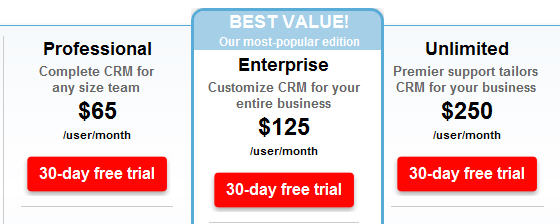The concept of subscription billing has been around for as long as there have been newspapers and magazines. The idea of paying a fixed amount on a regular basis for a product has definitely carried over to the digital world, but with a juicy twist. Instead of requesting a fixed payment amount at a consistent interval for all customers, digital product providers can specify usage-based costs to any increment they choose – per product, per minute, per second, per gigabyte.
So listen up content, software, games and media providers. If you are ignoring usage-based subscription billing models, you could be leaving serious money on the table.
Whether a product is truly software-as-a-service (SaaS), which Gartner defines as “software that’s owned, delivered and managed remotely by one or more providers,” or simply a product that requires regular payments to continue to use, most times companies utilize subscription billing to charge customers for the right to use a product.
Salesforce, a great example of a true SaaS product, and Norton 360, a downloadable anti-virus product, both utilize subscription billing to charge their customers.
In Salesforce’s case, customers choose from multiple subscription levels that enable different features as soon as they “upgrade.”

The different levels are based on feature rights that are enabled at that different billing levels.

This is not what we mean by usage-based subscription.
In Norton’s case, customers choose from different product versions with subscription options that terminate the product after a fixed period of time.

This is also not what we mean by usage-based subscription.
So, what do we mean by usage-based subscription?
A true usage-based subscription model is one where customers subscribe to a service where the amount charged each billing period is determined by how much the customer “used” the system/program. In North America, mobile phone plans often are a fixed price like $39 per month for 1,000 minutes plus $0.19 per minute thereafter. In this model, the customer can use up to their regular monthly minute limit, then get charged for their usage beyond the limit.
The benefit to the mobile phone providers is controlling the usage on their networks. Look at all the problems AT&T is having in the U.S. with iPhone 3G usage causing network problems. If AT&T had a usage-based model of flat monthly fee plus usage over a certain amount, AT&T may have fewer outages and more positive customer feedback.
A good example of a company that should be considering a usage-based model is Hulu. Hulu Plus, which was introduced in June, is a subscription product that costs $7.99 per month and allows customers to watch more shows on different devices than offered with the free version of Hulu. If Hulu put a limit of 100 hours per month on the Plus subscription and charged an additional $1.99 per additional 10 hours of TV watched, they could monetize those heavy users who account for a disproportionate level of Hulu service usage. Hulu is following a great introduction model for their products. However, they may see significant revenue advantages if they add a third step to optimize their offerings with usage-based billing.
- Market share – Give away a free product to build the user base
- Monetize – Offer the upgraded version as a subscription
- Optimize – Charge heavy users a usage premium over the standard subscription amount
Under what circumstances would it be advantageous to offer usage-based billing models?
Well, there are a variety of scenarios in which usage-based billing would be appropriate, depending on the market of course:
- Media (music, video, content) – A company offers a library of on-demand studio songs or live concerts and wants to monetize casual users while also charging heavy users appropriately. All users are charged $9.99 per month, but any usage over a specified limit would be charged at an additional $0.25 per use.
- Games – A gaming company wants to monetize in-application usage and an annual fee. Users pay $39.99 for the product each year, but also pay $1.99 for items purchased within the game play.
- Software – An anti-virus company wants to sell their product to an organization based upon the number of concurrent users. There can be a $1,000 base monthly price and a $4.99 per user per month charge depending on if the maximum number of monthly users was reached.
- SaaS – A website wants to sell file storage without allowing unlimited usage. The company can offer a baseline monthly price of $14.95 for a certain amount of storage space with each GB thereafter costing $1.99.
There are many ways to leverage usage-based subscriptions. Companies can use a variety of measures to implement usage-based billing, including:
- Maximum number of concurrent users
- Number of named users
- Number of files scanned, saved or printed
- Number of emails received
- Number of installations
- Amount of storage space used
- Total sum of time software used
Done correctly, usage-based subscription models can be more lucrative to digital product manufacturers than subscription billing alone. If you aren’t considering this model for the scenarios like the ones outlined above, you could be missing out on additional revenue.
Keystone
Usage-based subscriptions are a profitable billing option to enhance traditional subscription billing models. Carefully consider this option even if you already have a subscription billing model.
Do you know of any companies that have employed usage-based subscription billing models? As a user, do you have a positive or negative opinion of these sites because of its billing model?
Great topic.
There a many companies that are exploring usage based billing models to better support their business models. Today just about any cloud provider (public or private) is grappling with developing or leveraging a billing system for their offering. Whether it be EC2, or Azure etc.. they are focusing on compute hours, gig/terabytes, or elasticity. This model is also making its way into the Cloud App / SaaS space as well and due to the nature of our business we see it more every day.
As a resource, there is a new group on LinkedIn called “Cloud & Saas Startups” that has also been exploring some new pricing models and trends in the industry.
Hi Curt,
I couldn’t agree more that the cloud is changing the way companies will/are thinking about billing models. But what about the acceptance of such models online by consumers? Have you seen any backlash?
Thanks for the information about the LinkedIn group. It’s always good to have as many independent sources as possible!
cheers,
craig.
From a consumer perspective the model that dominates is still simplicity, although there are more business that we talk to who consider usage like an SMS texting model. There is a “charge” per sms but many people find it more useful to buy “buckets” of sms or upgrade to the unlimited plan.
We also see consumer usage charges on the digital media front. Think Amazon video on-demand. You “pay per watch” or perhaps in the “Amazon MP3 download” model. Consumers like being presented the metered version, but they want an option to limit their downside with a greater brand commitment.
Metered consumer usage is great, but it has to “make sense to the purchaser”, be easy to understand and consumers need available options if they find the plan too onerous.